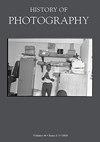Photography in the Big Frame: Conflicting Media Uses of the 1931 Arrest Photograph of the Scottsboro Nine
IF 0.2
2区 艺术学
0 ART
引用次数: 0
Abstract
On 25 March 1931 nine young African Americans were arrested in Alabama for the alleged rape of two White women, nearly lynched, sentenced to death and eventually incarcerated for years. This article examines the arrest photograph of the Scottsboro Nine and enacts a ‘social biography’ in exploring its conflicting uses in American media. The article proposes that it is an ‘averted lynching photograph’ that echoes images of actual lynch mob killings. Southern newspapers used leading captions with encoded racial hierarchies that framed the Nine as violators of White womanhood. Conversely, radical media reframed the photograph, arguing that a ‘frame-up’ trial constituted a ‘legal lynching’. The Communist organisation International Labor Defense led the campaign to acquit the defendants, and its magazine Labor Defender reproduced the photograph extensively in polemical photomontages. Diverse uses in African American media varied from analogous captioning in the combative Chicago Defender to its pertinent absence in the National Association for the Advancement of Colored People’s forum The Crisis. Many of these media framings fostered the abjection and victimhood of the Nine, whether in condemnation or sympathy. The photograph was a site of contestation of conflicting values concerning race, in which the subjects had little agency.大框架下的摄影:媒体对1931年斯科茨伯勒九人被捕照片的冲突使用
1931年3月25日,九名年轻的非裔美国人在阿拉巴马州被捕,罪名是强奸两名白人妇女,差点被私刑处死,被判处死刑,最终被监禁多年。这篇文章研究了斯科茨伯勒九人被捕的照片,并为探索其在美国媒体中的相互冲突的用途而制定了一本“社会传记”。这篇文章提出,这是一张“避免私刑的照片”,与实际私刑暴徒杀人的图像相呼应。南方报纸使用了带有编码种族等级的标题,将九人诬陷为违反白人女性身份的人。相反,激进媒体重新定义了这张照片,认为“陷害”审判构成了“合法私刑”。共产主义组织国际劳工辩护组织领导了宣布被告无罪的运动,其杂志《劳工辩护人》以充满争议的照片封面广泛复制了这张照片。非裔美国人媒体的使用方式多种多样,从好斗的《芝加哥捍卫者》中的类似字幕,到全国有色人种协进会论坛《危机》中的相关缺席。无论是谴责还是同情,这些媒体框架中的许多都助长了“九人组”的轻蔑和受害者身份。这张照片是一个关于种族的相互冲突的价值观的争论场所,在这个地方,受试者几乎没有代理权。
本文章由计算机程序翻译,如有差异,请以英文原文为准。
求助全文
约1分钟内获得全文
求助全文
来源期刊
CiteScore
0.30
自引率
50.00%
发文量
23
期刊介绍:
History of Photography is an international quarterly devoted to the history, practice and theory of photography. It intends to address all aspects of the medium, treating the processes, circulation, functions, and reception of photography in all its aspects, including documentary, popular and polemical work as well as fine art photography. The goal of the journal is to be inclusive and interdisciplinary in nature, welcoming all scholarly approaches, whether archival, historical, art historical, anthropological, sociological or theoretical. It is intended also to embrace world photography, ranging from Europe and the Americas to the Far East.

 求助内容:
求助内容: 应助结果提醒方式:
应助结果提醒方式:


